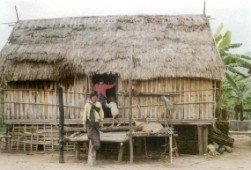(VOVworld) – Like many ethic minority groups in the Central Highlands, the Brau people attach importance to choosing land for building houses. A Brau village with a Rong communal house surrounded by smaller wooden houses symbolizes communal strength and reflects the customs and folk architecture of the Brau.
 |
Previously, the Brau people established their villages on hills and their villages have a distinctive architecture. Houses usually face the Rong communal house, which stands out in the village. A Brau traditional house is the long house on stilts, where several generations of a family live together. The house is enlarged when a son or a daughter gets married and the kitchen is divided to match the number of smaller families. Nguyen Van Nam, a tour guide in Kon Tum province, told VOV: “Formerly, when the Brau people used to live in the forests, houses on stilts protected them from wild animals, snakes, and insects. Cattle and poultry are raised under the floor. Each house should have a fire in the middle for cooking and keeping warm”.
The Brau house has sloped thatch-roofs. The floor is made of bamboo or another kind of wood. Owners beautify their houses by decorating their roofs with bamboo wattles in the shape of bird heads, baskets, the sun, or fans. The floor is divided into different parts: the lower floor is where the rice mortars are located and the upper floor is a place for relaxing or sewing. The inner chambers are also divided into 2 floors: on the lower floor a fire and water pipes are placed, while the upper floor is for sleeping. Outbuildings are used to store food, farm tools and family appliances.
 |
| (Photo: cema.gov.vn) |
In a traditional Brau village, the Rong communal house is the center of local activities. It is erected and decorated by the villagers themselves. Made of wood, bamboo, and thatch, the Rong house is more solid and complex than an ordinary house. The Rong pillars are big and made of precious wood. The huge, sloping roofs are elaborately decorated, embodying the pride of the whole village. The Rong house is a sacred venue for major rituals of the villagers, such as a gong festival to celebrate a new village, a house warming festival, and rice sowing and harvesting festivals. Village elder Thao La of Dak Me hamlet, Ngoc Hoi district, Kon Tum province, told us: “The Brau people follow the custom of worshipping the gods of land, mountains, and water. They pray for comfortable, cool housing, longevity, happiness, and prosperity for all villagers”.
Since 1999 the Brau people have resettled in Dak Me hamlet, Ngoc Hoi district, Kon Tum province instead of living a nomadic life. The State has given them with land and seedlings for farming and 1.5 million USD to build concrete pillars for housing, a Rong communal house, and 2 wooden houses. Dak Me hamlet now looks like a small street in the middle of a forest. Hunger, poverty and outdated customs have been eliminated. Thanks to community support and State assistance, nearly 400 Brau people have decent housing and a stable life in Vietnam’s Central Highlands.